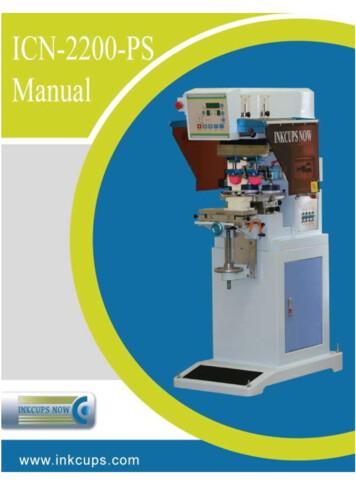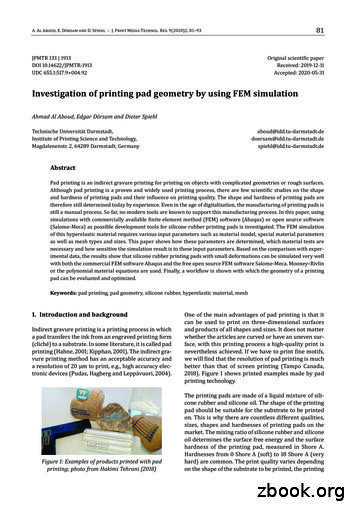TM-C3500 Quick Printing Guide (for NiceLabel)
Quick Printing Guide (for NiceLabel)M00086800Rev.A
TrademarksEPSON is a registered trademark of Seiko Epson Corporation.Exceed Your Vision is registered trademark or trademark of Seiko Epson Corporation.NiceLabel and NiceLabel Pro are registered trademark or trademark of Euro Plus d.o.o. in the United Statesand other countries.In this manual, the NiceLabel GUI is used with the permission of Euro Plus d.o.o.All other trademarks are the property of their respective owners and used for identification purpose only. Seiko Epson Corporation 2015. All rights reserved.2
OverviewThis manual contains necessary information to print on Euro Plus "NiceLabel Pro 6.3.1" (NiceLabel), using TM-C3500.Here we will use the following print data as an example. Change the content based on the actual use environment. Media Type:Matte Label (Roll Paper) Label Sizd:72.0 x 51.0 mm (Die-cut Label) Printed Information:Text DataPicture DataBarcode Data(Barcode Type: CODE39)Install NiceLabel beforehand.See the NiceLabel manual for how to install and operate BarTender.See the "TM-C3500 Technical Reference Guide" for details on how to use the printer and printer driver.Caution:The usage may differ when printing with a different version or edition of NiceLabel.3
Preparation of the Printer1Insert the supplied CD into the computer, and set up the printer according to thesetup tool instructions.Note:The printer driver is installed automatically if it has not been installed.2"Media Layout Creation" Dialog appears. Select [Yes], then click [Next].3Specify the media source to be used. Select [Roll Paper], then click [Next].4
4Specify the media form to be used. Select [Die-cut Label (Gap)], then click [Next].5Specify the size of the paper to be used, as shown below. Then click [Next].Specified paper size will be registered to the default settings of the printer driver.Setting Items6Setting ValueMedia Layout NameEPSONLABEL (Optional)Label Width72.0 mmLabel Length51.0 mmAfter specifying the default print settings, set up the printer by following theinstructions of the setup tool.When using multiple media layouts with different media form, register and set multiple media sizes to the printer. Fordetail, see the "TM-C3500 Technical Reference Guide".When using multiple media layouts with different media sizes, register the media layout in NiceLabel.5
Preparation of NiceLabel123Start NiceLabel to create a new label.Specify the printer. Select [EPSON TM-C3500], then click [Next].Specify the Stock type. Select [ NONE ], then click [Next].6
4Specify the Page size.Specify as shown below, and then click [Next].Setting Items5Setting Value(Method of adjusting the page size)Automatically set from label dimensionsPage sizeNiceLabel Pro custom layoutMedia TypeDie-cut labelSpecify the Orientation. Select [Portrait], then click [Next].7
67Specify the label size. Specify as shown below, and then click [Next].Setting ItemsSetting ValueLabel width72.0 mmLabel height51.0 mmTop Margin0 mmBottom Margin0 mmLeft Margin0 mmRight Margin0 mmFollow the wizard instructions to create a document.8
Creating Label DesignSee the following and create a label design using NiceLabel.Make sure you have the top, bottom, left, and right margins of 1.5 mm and more inside the label size.Picture dataText dataBarcode data[Text] Object[Barcode] Object[Picture] Object Use the Text Object to insert Text Data. Use the Image Object to insert Picture Data. Use the Barcode Object to insert Barcode Data.For detail, refer to the NiceLabel manual.9
Barcode SettingsIn the barcode properties, set the Narrow bar width to more than "4" dots and the ratio to "2.5".Notes:When printing a barcode, there are recommended conditions according to the Media Type. If the recommendedconditions are not followed, the printed barcode may not be read properly. For the recommended conditions, see theappendix.10
AppendixRecommended conditions of the BarcodeBarcode DirectionMedia TypeFenceLadderNiceLabel settings(Recommended minimum value)Printer Driver settingsRatio *Narrow bar widthPlain, Plain Label42.5Other than above42.5Plain, Plain Label62.5Other than above62.5Paper feed directionPaper feed direction*: You can set the ratio when the barcode type is Codabar, CODE39, Interleaved 2 of 5, or MSI.Fence bar codeLadder bar codeCautions: The above values are valid when using paper recommended by EPSON. Before using the barcode, print the barcode and check the scan quality.11
Barcode font Function of the Printer DriverWhen printing a barcode that has higher reading quality than a NiceLabel barcode, you can use the printer driver'sbarcode font.Use the following method.1In printer driver's "Barcode and 2D Symbol" settings, register the barcode font forwhich you specified the barcode type, size, rotation direction, and so on.2In printer driver's "Font Replacement" settings, replace the registered barcode fontwith TrueType font.3On a NiceLabel, enter the barcode value using the "Text" object as text data, andspecify the replaced TrueType font.Notes: For more details on how to set the printer driver, see "TM-C3500 Technical Reference Guide". The barcode is displayed as text data on the NiceLabel screen and is not displayed as a barcode image. When youwant to check the barcode image, use the printer driver's preview function.12
This manual contains necessary information to print on Euro Plus "NiceLabel Pro 6.3.1" (NiceLabel), using TM-C3500. Here we will use the following print data as an example. Change the content based on the actual use environment. Media Type: Matte Label (Roll Paper) Label
– Configure the Ricoh Aficio MP C3500/C4500 with either a 1,000-Sheet Finisher, 2,000-Sheet Booklet Finisher or 3,000-Sheet Finisher. As secure as you want it. The security of your documents and your network needs to be iron clad. The Ricoh Aficio MP C2500/C3000 & C3500/C4500 Series protects both at every step in your document workflow.
Printing Business Opportunity, Paper Publishing Unit, Screen Printing, Offset Printing Press, Rotogravure Printing, Desk Top Publishing, Computer Forms and Security Printing Press, Printing Inks, Ink for Hot Stamping Foil, Screen Printing on Cotton, Polyester and Acrylics, Starting an Offset Printing Press, Commercial Printing Press, Small .
The Poor Man’s Way to Riches Publishing History 1st printing 2nd printing 3rd printing 4th printing 5th printing 6th printing 7th printing 8th printing 9th printing December 1976 June 1977 January 1978 December 1978 August 1979 January 1980 July 1980 May 1981 April 1987
-TAB BOOKS . First Printing July, 1958 Second Printing - July, 1959 Third Printing-November, 1960 Fourth Printing - September, 1961 Fifth Printing - August, 1962 Sixth Printing - March, 1964 Seventh Printing - October, 1965 Eighth Printing - December, 1966 Ninth Printing -April, 1968
extent, pad printing also replaces other decorating processes, such as screen printing, labeling and hot stamping. The form used for pad printing is a plate of etched steel or washed out pho-topolymer. As with intaglio, the image printing elements are contained (etched) in the non-printing surface. During a printing operation, the plate is .
Learning about Pad Printing APPLICATIONS OF PAD PRINTING Transfer pad printing or tampo printing, commonly known as pad printing, is an "indirect offset gravure" printing process. It was originally used in the watch making industry in Switzerland to decorate watch faces. Pad printing has now developed to a point where it is one of the
Indirect gravure printing is a printing process in which a pad transfers the ink from an engraved printing form (cliché) to a substrate. In some literature, it is called pad printing (Hahne, 2001; Kipphan, 2001). The indirect gra-vure printing method has an acceptable accuracy and a resolution of 20 μm to print, e.g., high accuracy elec-
Introduction to Quantum Field Theory John Cardy Michaelmas Term 2010 { Version 13/9/10 Abstract These notes are intendedtosupplementthe lecturecourse ‘Introduction toQuan-tum Field Theory’ and are not intended for wider distribution. Any errors or obvious omissions should be communicated to me at j.cardy1@physics.ox.ac.uk. Contents 1 A Brief History of Quantum Field Theory 2 2 The Feynman .























